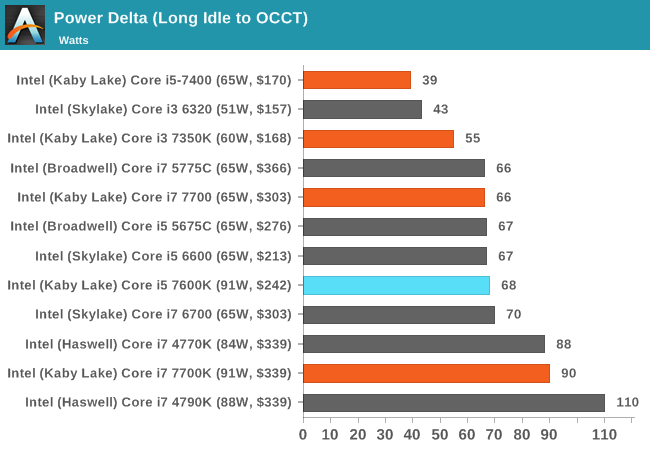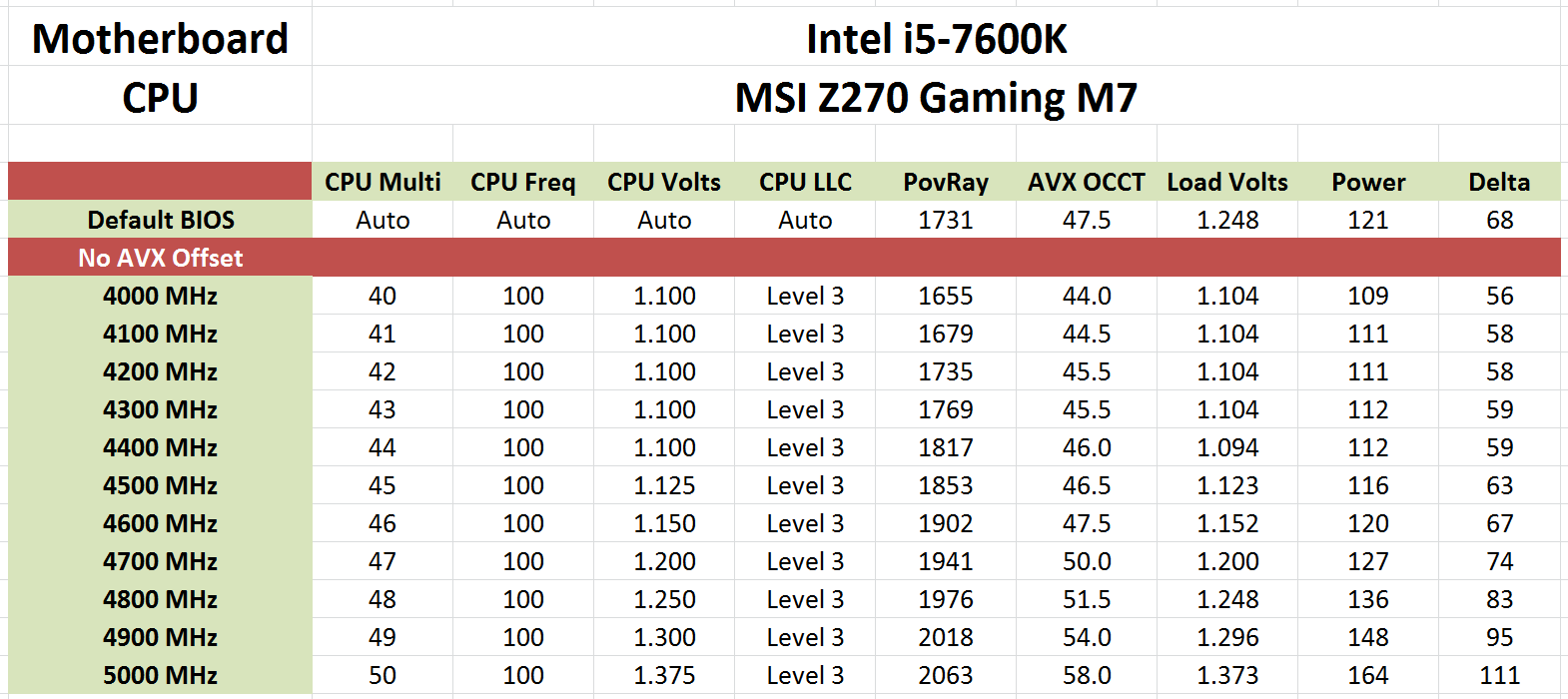The Intel Core i5-7600K (91W) Review: The More Amenable Mainstream Performer
by Ian Cutress on January 3, 2017 12:01 PM ESTPower Consumption
As with all the major processor launches in the past few years, performance is nothing without a good efficiency to go with it. Doing more work for less power is a design mantra across all semiconductor firms, and teaching silicon designers to build for power has been a tough job (they all want performance first, naturally). Of course there might be other tradeoffs, such as design complexity or die area, but no-one ever said designing a CPU through to silicon was easy. Most semiconductor companies that ship processors do so with a Thermal Design Power, which has caused some arguments recently based presentations broadcast about upcoming hardware.
Yes, technically the TDP rating is not the power draw. It’s a number given by the manufacturer to the OEM/system designer to ensure that the appropriate thermal cooling mechanism is employed: if you have a 65W TDP piece of silicon, the thermal solution must support at least 65W without going into heat soak. Both Intel and AMD also have different ways of rating TDP, either as a function of peak output running all the instructions at once, or as an indication of a ‘real-world peak’ rather than a power virus. This is a contentious issue, especially when I’m going to say that while TDP isn’t power, it’s still a pretty good metric of what you should expect to see in terms of power draw in prosumer style scenarios.
So for our power analysis, we do the following: in a system using one reasonable sized memory stick per channel at JEDEC specifications, a good cooler with a single fan, and a GTX 770 installed, we look at the long idle in-Windows power draw, and a mixed AVX power draw given by OCCT (a tool used for stability testing). The difference between the two, with a good power supply that is nice and efficient in the intended range (85%+ from 50W and up), we get a good qualitative comparison between processors. I say qualitative as these numbers aren’t absolute, as these are at-wall VA numbers based on power you are charged for, rather than consumption. I am working with our PSU reviewer, E.Fylladikatis, in order to find the best way to do the latter, especially when working at scale.
Nonetheless, here are our recent results for Kaby Lake at stock frequencies:

The Core i5-7600K, despite the 91W TDP rating, only achieved 63W in our power test. This is relatively interesting, suggesting that the Core i5 sits in a good power bracket for voltage (we see that with overclocking below), but also the mixed-AVX loading only starts piling on the power consumption when there are two hyperthreads going for those instructions at the same time per core. When there’s only one thread per core for AVX, there seems to be enough time for each of the AVX units to slow down and speed back up, reducing overall power consumption.
Overclocking
At this point I’ll assume that as an AnandTech reader, you are au fait with the core concepts of overclocking, the reason why people do it, and potentially how to do it yourself. The core enthusiast community always loves something for nothing, so Intel has put its high-end SKUs up as unlocked for people to play with. As a result, we still see a lot of users running a Sandy Bridge i7-2600K heavily overclocked for a daily system, as the performance they get from it is still highly competitive.
There’s also a new feature worth mentioning before we get into the meat: AVX Offset. We go into this more in our bigger overclocking piece, but the crux is that AVX instructions are power hungry and hurt stability when overclocked. The new Kaby Lake processors come with BIOS options to implement an offset for these instructions in the form of a negative multiplier. As a result, a user can stick on a high main overclock with a reduced AVX frequency for when the odd instruction comes along that would have previously caused the system to crash.
We used the AVX Offset option when we overclocking the Core i7-7700K and achieved another 100-200 MHz extra frequency for non-AVX before succumbing to overheating. Ultimately that’s not a lot of frequency, but that can be enough for some users. With the Core i5-7600K, we got a great result without even touching the AVX offset option:
Straight out of the box, our retail sample achieved an OCCT stable 5.0 GHz with mixed AVX at a 1.375V setting, with the software recording only 58C peak on the core and a maximum power draw of 111W. That’s fairly astonishing – from the base 3.8/4.2 GHz we were able to get up to 800 MHz in an overclock for just under double the power draw (or, +20W over TDP).











70 Comments
View All Comments
Chaitanya - Tuesday, January 3, 2017 - link
Probably the most useless upgrade in recent years for PC users.Sabresiberian - Tuesday, January 3, 2017 - link
1) This is only an optimization of an existing architecture, and2) Anyone knowledgeable will almost always recommend skipping at least one architectural generation and, especially considering the slow improvements over the last 5 years, at least 2 generations. Which means if you are in a use-case scenario that can take advantage of the increased CPU performance you shouldn't be thinking "upgrade" unless you are running Sandy Bridge or earlier.
(The obvious exception that breaks the rule here is Zen, which will offer a huge performance increase over Bulldozer.)
Shadow7037932 - Wednesday, January 4, 2017 - link
>(The obvious exception that breaks the rule here is Zen, which will offer a huge performance increase over Bulldozer.)How about we wait until it's actually released? Remember what happened with the original Phenom?
silverblue - Wednesday, January 4, 2017 - link
I don't think it's unreasonable to get excited about Zen, at least in terms of AMD's current product lines. Potentially massively optimised benchmarks aside, at least they tested Ryzen engineering samples against Intel's more expensive offerings in public without resorting to slides containing unsubstantiated performance claims. In fact, the only thing I can see in print is the "40% faster than Excavator" claim. If the Canard PC leaks aren't fake, there's every chance that AMD have achieved this, and possibly exceeded it.You mentioned Phenom, so let's take a trip down memory lane:
Phenom: "40% faster than Core 2 Quad at the same clock speed"
Reality: Up to 40% slower per clock after the TLB bug; needed Phenom II to really close the gap.
Bulldozer: "50% faster than the i7 950"
Reality: In what test? Even the 8350 couldn't boast this.
I don't see Ryzen being the gaming top dog - remember, current productivity and gaming demos have been against slower clocked CPUs with double the cores of your garden variety, highly clocked i5 and i7 - but I don't think it's unreasonable to expect that it'll bury the FX series. IMHO, of course.
boozed - Friday, January 6, 2017 - link
I think the problem is that if Skylake wasn't enough of a performance improvement to upgrade, neither is Kaby Lake.Murloc - Tuesday, January 3, 2017 - link
is it?I'm running a nehalem, if I was upgrading now I'd appreciate the lower power consumption and the HEVC hardware support.
willis936 - Wednesday, January 4, 2017 - link
Was HEVC hardware not present on the 6x00 series?Shadow7037932 - Wednesday, January 4, 2017 - link
He said Nehalem, which is the i7 920 and the like.close - Wednesday, January 4, 2017 - link
@Shadow7037932, can you name one good reason why he should update his Nehalem to a Kaby Lake K part that didn't exist one and a half years ago with Skylake?I'll put it another way: If someone passed on a Skylake upgrade last year why exactly would they pay the same price to get a pre-overclocked Skylake (aka Kaby Lake) this year? Why did the user suffer through an extra ~18 months of really aging hardware just to buy what's basically the same CPU at the same price today?
Since these 2 generations share architecture and fabrication process there's no reason to expect consistently better OC on the 7 series. So the 300MHz should be within reach for any K part and any user.
MonkeyPaw - Tuesday, January 3, 2017 - link
Looks like it is the best 14nm Intel architecture you can buy. Still, it seems like if you're in the market now, you might as well wait to see if Ryzen will be a compelling option. If nothing else it might help drive some of these prices down.